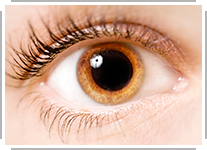Tx: Physical SxS
 |
Treatment |
Select each tab below for more information. | |
Headache
Primary care doctors are familiar with normal headache presentations, but post-concussive headaches can be multifactorial. Some physicians, usually neurologists, specialize in the medical management of headaches. In addition, the expertise of a multidisciplinary team can provide insights into the potential causes as well as a range of treatment options.
Post-traumatic headache can be a major culprit in delayed recovery, but it is not a diagnostic label. Knowing pre-existing headache causes and frequency will enable you to determine the origin of the patient’s post-traumatic headache. A persistent headache may be unrelated to the mTBI. It could result from a neck injury, for example. Knowing the headache type (cervicogenic pain, occipital neuritis, migraine, tension headache, or vision-related) will help you treat it. |
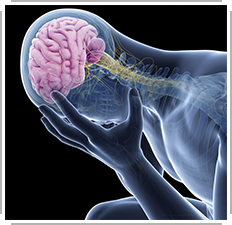 Courtesy ThinkStock: Eraxion |
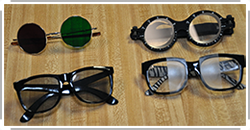 Courtesy Madonna Rehabilitation Hospital |
Possible Headache Tx
|
Balance / Vestibular
There are multiple types of balance disorders. Some resolve quickly, but others require more time. Balance can be multifactorial, involving:
Postural stability is less likely to be an issue in young athletes, but should be considered when assessing the patient. |
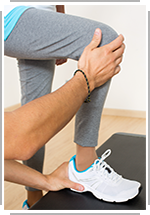 Courtesy ThinkStock: AdamGregor |
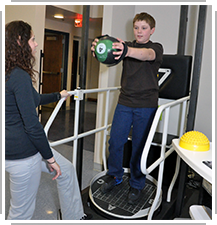 Courtesy Madonna Rehabilitation Hospital |
Possible Balance / Vestibular TxDepending on the etiology (causation), some symptoms respond quickly to treatment. For example, when correctly diagnosed, Benign Paroxysmal Positional Vertigo often resolves in a few sessions of proper treatment. By contrast, central balance (i.e., arising from the brain) or dizziness problems may require weeks of specialized exercises and desensitization therapies. |
Frequently, patients with delayed recovery from concussion present with previously undiagnosed visual disturbances. (There are various estimates as to how often.) Head injury sometimes brings such disturbances to light.1
Ellis et al (2017). Clinical predictors of vestibulo-ocular dysfunction in pediatric sports-related concussion. Journal of Neurosurgery, Pediatrics, 19, 38-45
|
 Courtesy Madonna Rehabilitation Hospital |
Possible Vision Disturbance TxTreatments may involve special lenses and prisms, tinted lenses for contrast sensitivity, and / or binasal occlusion. Appropriate therapy may also include:
|
Fatigue
When you assess fatigue, it’s important to determine the type of fatigue the patient is experiencing. Fatigue has two components: physical and mental. Activities that previously took little effort may require great amounts of energy after an mTBI. As a result, the patient may experience an overwhelming sense of tiredness that can be physical, mental, or both.
Fatigue may directly impact a young person’s academic and physical performance by making sustained daily activities, attention, concentration, memory, communication, and emotional control more difficult. |
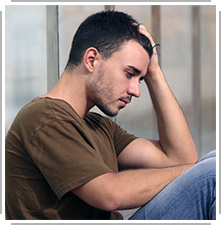 Courtesy ThinkStock: AntonioGuillem |
 Courtesy ThinkStock: moodboard |
Possible Fatigue Tx
See: Schneider KJ, Leddy JJ, Guskiewicz KM, Seifert T, McCrea M, Silverberg ND, Feddermann-Demont N, Iverson GL, Hayden A, Makdissi M. Rest and treatment/rehabilitation following sports-related concussion: A systematic review. Br J Sports Med. 2017 Jun;51(12):930-934
|
Sleep
Issues with sleep are not the same as issues with fatigue. Sleep is important. It is healing time for the young person recovering from an mTBI. Your patient must not return to his or her previous sleeping pattern if it was insufficient. For example, a teenager’s typical seven hours per night is not enough.
Visit the National Sleep Foundation website for recommended sleep times per age group. |
 Courtesy ThinkStock: DragonImages |
 Possible Sleep Issues TxThere are two major considerations in treating sleep problems. |
- If the sleep issues are chronic, the issues should be addressed by sleep specialists, such as ENTs, otolaryngologists, and / or neurologists.
- It’s important to make sure the patient is getting enough sleep acutely. This is true for all youth, but especially true if a child is injured. A concussion patient may need to sleep more, immediately after injury as well as in cases of Post-Concussion Syndrome. Naps, even in school, may be important to recovery. Parents should let the young person sleep, and even encourage sleep if necessary, intervening to help reduce bad bedtime habits:
- Make bedtime a time to go to bed and sleep. Ensure the youth goes to bed at a consistent time every night.
- Practice good sleep hygiene: no computers, phones, screens, or LEDs close to the bed.
- Make sure the patient doesn’t do anything in the bed except sleep: for example, no reading or watching television.
 Courtesy ThinkStock: pixologicstudio
|
A Special Note about PainPain is a huge, complicating factor. You may confound pain with head injury or head injury with pain, treating one but missing the other. Pain is a distractor. For example, pain from a knee injury might distract the patient’s attention and undermine the patient’s performance on tests. A major concern with multiple concussions and PCS is the impact of headaches and chronic pain. Regardless of whether pain is due to the head trauma or due to a different source, you will need to understand the pain’s relationship to the head injury. You need to diagnose the cause of the pain and treat it. |
1 Ciuffreda KJ, Kapoor N, Rutner D et al. Occurrence of oculomotor dysfunctions in acquired brain injury: a retrospective analysis. Optometry 2007; 78: 155-161. |

